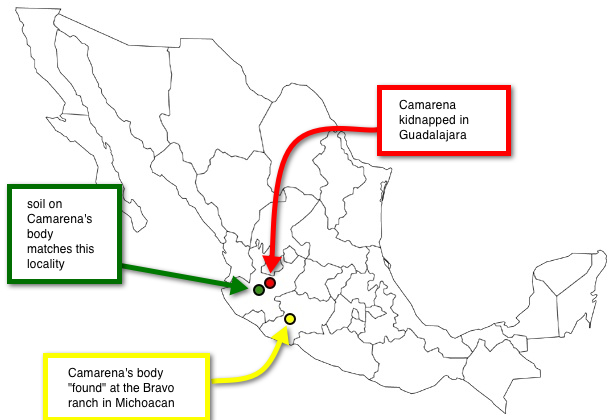The reading assignment for this lesson is an account of some detective work done by geologists working for the FBI during the 1980s. They used forensic mineralogy to find the burial site of an undercover US DEA agent who had been killed in Mexico. One of the reasons I like this article is that it presents a case study. It's almost a story with a plot line, so it is a nice break from reading scientific articles. Furthermore, it puts into context why studying mineralogy and knowing how to identify certain types of rocks and minerals has important applications. Another reason I like it is that it synthesizes some of the material we've already covered in this course and in other courses in the M.Ed. program, while bringing up some new information, too. For example, we already know how to read geologic maps to get a feel for the plate tectonic structure of a region. After reading this article, we will study the tectonics of western Mexico and then extend our thinking to subduction zones, and volcanoes in particular.
Reading assignment
McPhee, J. (1996). The gravel page. The New Yorker, 71(46), 44, pp. 60-69.
Note that this reading is an excerpt from a larger article. Your assignment begins on page 60 under the heading "Death of an Agent," and ends on page 69 before Annie Leibovitz's article about showgirls in Vegas.
Overview
Here is a quick overview of the main points of McPhee's article: Witnesses saw Enrique Camarena kidnapped in broad daylight in Guadalajara (red dot on the map of Mexico, below). His body was later "found" by the MFJP at the Bravo family ranch in Michoacán (yellow dot on the map below). However, the soil from his body didn't match the soil at the Bravo ranch, it matched the soil in Bosques la Primavera state park in Jalisco (green dot on the map below).

The story hinges upon not just being able to differentiate between the two soils, but also upon being able to locate the real source of the soil on Camarena's body. In order to appreciate how the FBI geologists were able to do this, we will step back and discuss some basic points regarding mineralogic classifications and we will think about this in the wider framework of the mineralogic products of volcanoes. Knowing why certain volcanoes produce certain types of mineral assemblages comes from putting together a tectonic history of the volcanoes of interest, so we'll do this, too.